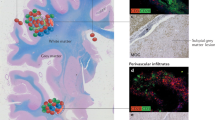Summary:
Multiple sclerosis (MS) is considered an inflammatory autoimmune disorder. Approved immunotherapies are only moderately effective in reducing disease exacerbations and brain inflammation in a subset of patients. Autologous hematopoietic stem cell transplantation (HSCT) has emerged in recent years as the first opportunity to offer to patients a radical, potentially curative treatment. Here, we will summarize key immunopathological aspects of MS and discuss important questions that need to be addressed to clarify the therapeutic role and mechanism of action of HSCT in this disorder.
This is a preview of subscription content, access via your institution
Access options
Subscribe to this journal
Receive 12 print issues and online access
$259.00 per year
only $21.58 per issue
Buy this article
- Purchase on Springer Link
- Instant access to full article PDF
Prices may be subject to local taxes which are calculated during checkout
Similar content being viewed by others
References
Noonan CW, Kathman SJ, White MC . Prevalence estimates for MS in the United States and evidence of an increasing trend for women. Neurology 2002; 58: 136–138.
Raine CS, McFarland HF, Tourtellotte WW . Multiple Sclerosis – Clinical and pathogenetic basis. Chapman & Hall Medical: London, 1997.
Trapp BD, Peterson J, Ransohoff RM et al. Axonal transection in the lesions of multiple sclerosis. [See comments.]. N Engl J Med 1998; 338: 278–285.
Lucchinetti C, Bruck W, Parisi J et al. Heterogeneity of multiple sclerosis lesions: implications for the pathogenesis of demyelination. Ann Neurol 2000; 47: 707–717.
Martin R, McFarland HF . Immunology of multiple sclerosis and experimental allergic encephalomyelitis. In: Raine CS, McFarland HF, Tourtellotte WW (eds). Multiple Sclerosis: Clinical and pathogenetic basis. Chapman & Hall: London, 1997. pp 221–242.
Goebels N, Hofstetter H, Schmidt S et al. Repertoire dynamics of autoreactive T cells in multiple sclerosis patients and healthy subjects - Epitope spreading versus clonal persistence. Brain 2000; 123: 508–518.
Vergelli M, Mazzanti B, Traggiai E et al. Short-term evolution of autoreactive T cell repertoire in multiple sclerosis. J Neurosci Res 2001; 66: 517–524.
Hellings N, Gelin G, Medaer R et al. Longitudinal study of antimyelin T-cell reactivity in relapsing-remitting multiple sclerosis: association with clinical and MRI activity. J Neuroimmunol 2002; 126: 143–160.
Bielekova B, Goodwin B, Richert N et al. Encephalitogenic potential of myelin basic protein peptide (83–99) in multiple sclerosis – Results of a phase II clinical trial with an altered peptide ligand. Nat Med 2000; 6: 1167–1175.
McFarland HF, Frank JA, Albert PS et al. Using gadolinium-enhanced magnetic resonance imaging lesions to monitor disease activity in multiple sclerosis. Ann Neurol 1992; 32: 758–766.
Neumann H, Schmidt H, Wekerle H . Interferon gamma gene expression in sensory neurons: evidence for autocrine gene regulation. J Exp Med 1997; 186: 2023.
Wucherpfennig KW, Catz I, Hausmann S et al. Recognition of the immunodominant myelin basic protein peptide by autoantibodies and HLA-DR2-restricted T cell clones from multiple sclerosis patients. Identity of key contact residues in the B-cell and T-cell epitopes. J Clin Invest 1997; 100: 1114–1122.
Goodin DS, Frohman EM, Garmany Jr GP et al. Disease modifying therapies in multiple sclerosis: report of the Therapeutics and Technology Assessment Subcommittee of the American Academy of Neurology and the MS Council for Clinical Practice Guidelines. Neurology 2002; 58: 169–178.
Openshaw H, Lund BT, Kashyap A et al. Peripheral blood stem cell transplantation in multiple sclerosis with busulfan and cyclophosphamide conditioning: report of toxicity and immunological monitoring. Biol Blood Marrow Transplant 2000; 6: 563–575.
Fassas A, Passweg JR, Anagnostopoulos A et al. Hematopoietic stem cell transplantation for multiple sclerosis. A retrospective multicenter study. J Neurol 2002; 249: 1088–1097.
Burt RK, Traynor AE, Pope R et al. Treatment of autoimmune disease by intense immunosuppressive conditioning and autologous hematopoietic stem cell transplantation. Blood 1998; 92: 3505–3514.
Fassas A, Anagnostopoulos A, Kazis A et al. Autologous stem cell transplantation in progressive multiple sclerosis – an interim analysis of efficacy. J Clin Immunol 2000; 20: 24–30.
Kozak T, Havrdova E, Pit'ha J et al. High-dose immunosuppressive therapy with PBPC support in the treatment of poor risk multiple sclerosis. Bone Marrow Transplant 2000; 25: 525–531.
Mancardi GL, Saccardi R, Filippi M et al. Autologous hematopoietic stem cell transplantation suppresses Gdenhanced MRI activity in MS. Neurology 2001; 57: 62–68.
Saiz A, Carreras E, Berenguer J et al. MRI and CSF oligoclonal bands after autologous hematopoietic stem cell transplantation in MS. Neurology 2001; 56: 1084–1089.
Fassas A, Anagnostopoulos A, Kazis A et al. Peripheral blood stem cell transplantation in the treatment of progressive multiple sclerosis: first results of a pilot study. Bone Marrow Transplant 1997; 20: 631–638.
Kim JH, Auerbach JM, Rodriguez-Gomez JA et al. Dopamine neurons derived from embryonic stem cells function in an animal model of Parkinson's disease. Nature 2002; 418: 50–56.
Mezey E, Key S, Vogelsang G et al. Transplanted bone marrow generates new neurons in human brains. Proc Natl Acad Sci USA 2003; 100: 1364–1369.
Mezey E, Chandross KJ, Harta G et al. Turning blood into brain: cells bearing neuronal antigens generated in vivo from bone marrow. Science 2000; 290: 1779–1782.
Author information
Authors and Affiliations
Rights and permissions
About this article
Cite this article
Muraro, P., Martin, R. Immunological questions on hematopoietic stem cell transplantation for multiple sclerosis. Bone Marrow Transplant 32 (Suppl 1), S41–S44 (2003). https://doi.org/10.1038/sj.bmt.1704096
Published:
Issue Date:
DOI: https://doi.org/10.1038/sj.bmt.1704096
Keywords
This article is cited by
-
Stem cell treatment for patients with autoimmune disease by systemic infusion of culture-expanded autologous adipose tissue derived mesenchymal stem cells
Journal of Translational Medicine (2011)



